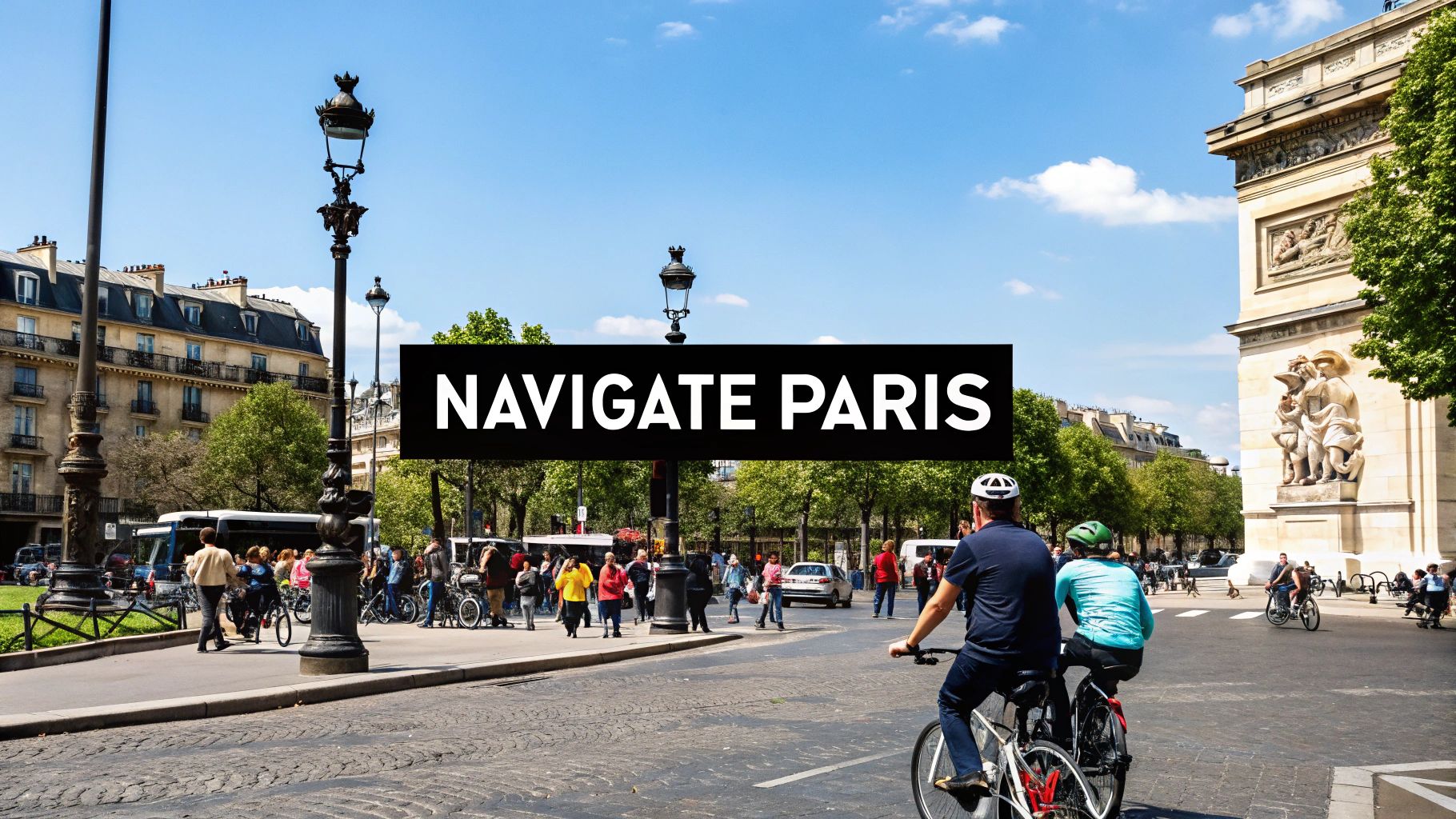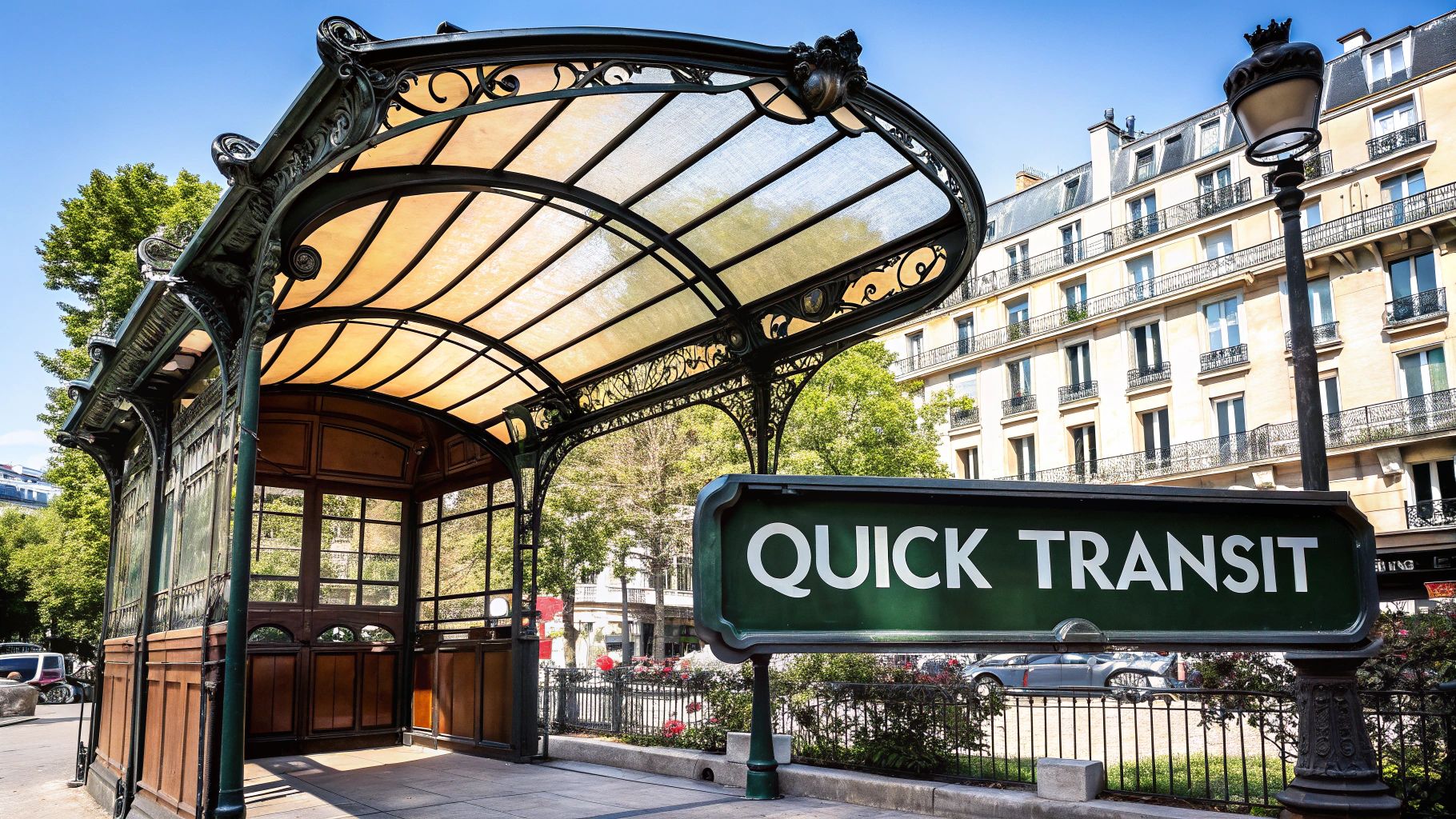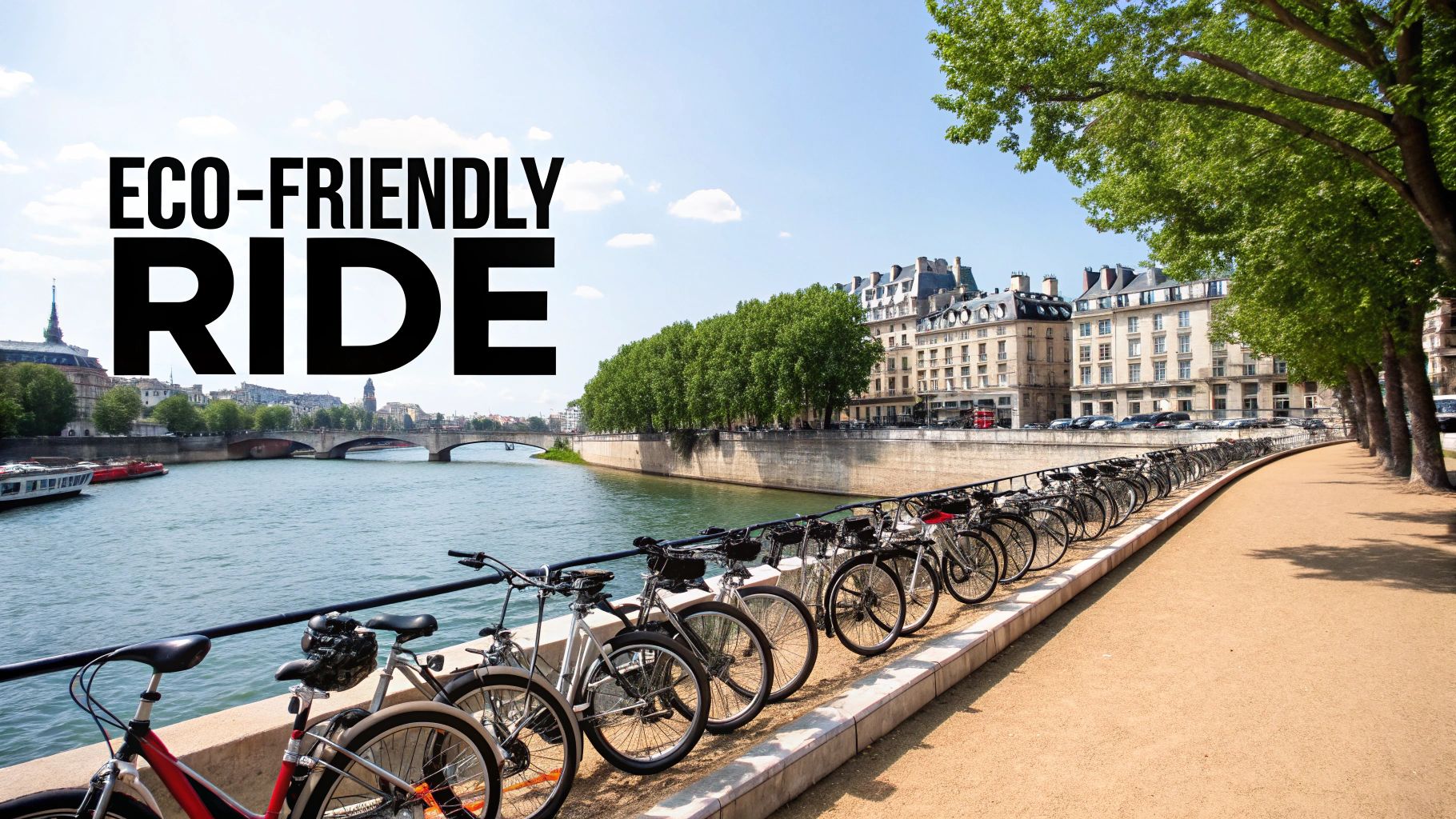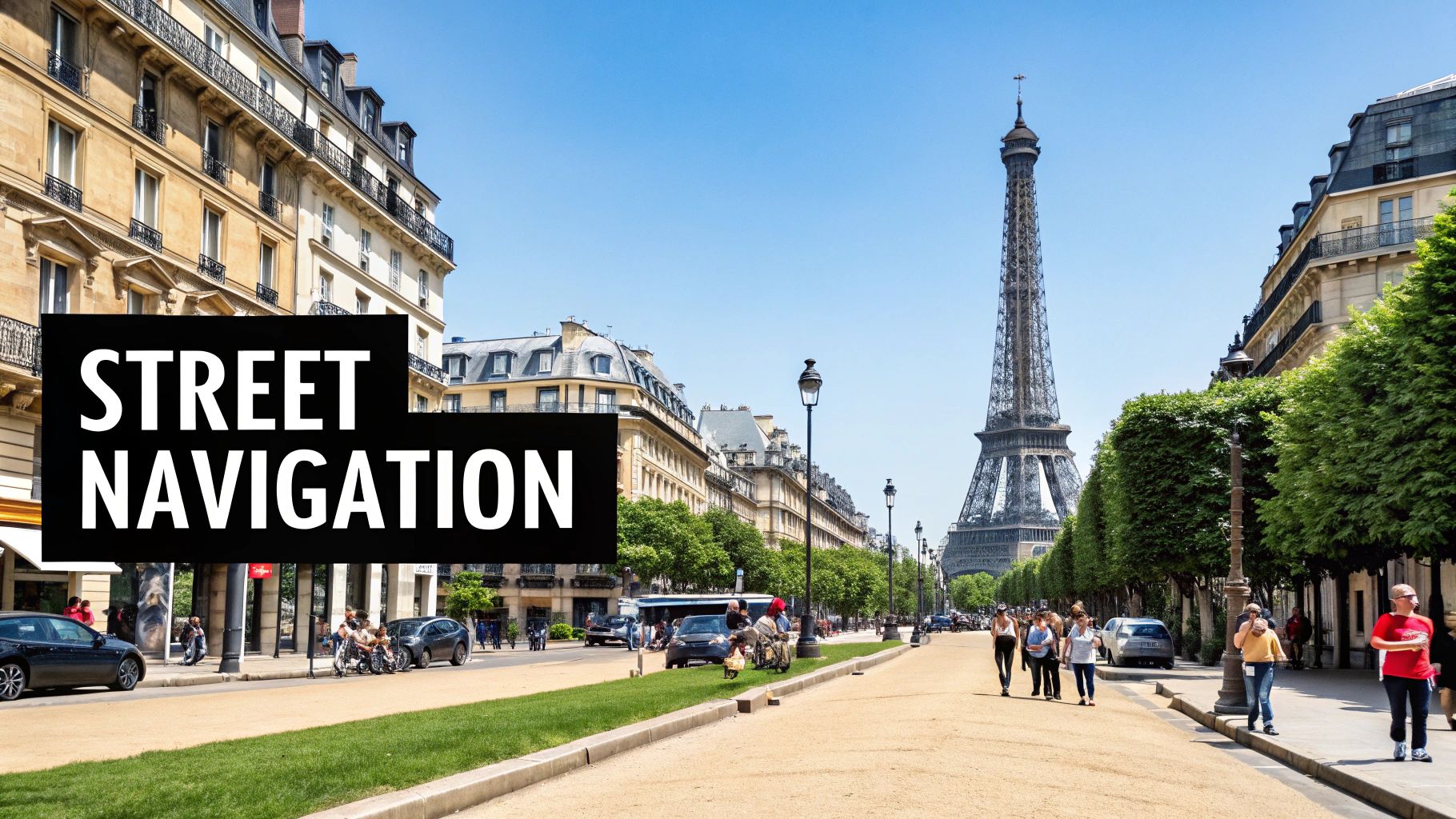Getting Around Paris: Your Complete Guide to Mastering City Navigation

Understanding Paris's Public Transport Network Like a Pro

Paris ofers one of the world's most complet public transporttion systems. The netwok smothly connects the Métro, RER trains, busses, and trams, making it simple to explor both central Paris and surounding areas. From the Louvree Museum to Disneyland Paris, you can reach nearly any destnation using public trasport.
Decoding the Métro and RER
The Paris Métro system features 16 color-coded lines that form the core of city transport. For instance, if you want to travel from the Eiffel Tower area to Notre Dame Cathedral, the Métro provides the most direct route. The RER trains serve a different purpose - they connect Paris with suburban areas and major hubs like Charles de Gaulle Airport. With fewer stops and faster service than the Métro, the RER works best for longer trips across the region.
Mastering Buses and Trams
While underground options work well for distance, buses and trams show you Paris from street level. Buses reach neighborhoods that aren't near Métro stations, taking you through charming streets and past historic buildings. Modern tram lines provide a comfortable ride with great views, especially in outer districts. Since they run above ground, you can watch city life unfold during your journey.
Choosing the Right Ticket for Your Needs
Understanding ticket options helps you travel efficiently and save money. Single-use t+ tickets work for quick trips. If you'll use transport often, consider a Navigo Découverte pass for weekly or monthly travel, or a Paris Visite pass that includes unlimited rides and attraction discounts within certain zones. The right pass can reduce costs and make travel easier. Learn more essential information in this guide to Paris Travel Tips and Good to Know.
Understanding Paris's Transport Usage
The numbers show how vital public transport is to Paris. In 2020, over 759 million people used the RER suburban trains. The greater Paris region (Île-de-France) houses more than 12 million residents, with nearly 70% choosing public transport for their daily commute. For detailed usage statistics, check this report. With such high ridership, visitors benefit from learning how the system works. Once you understand the Métro, RER, buses, and trams, plus ticketing options, you can navigate Paris confidently and enjoy stress-free travel.
Navigating Modern Paris: Recent Transit Transformations

Getting around Paris has changed significantly in recent years as new transportation options and improvements have rolled out across the city. For both locals and tourists, traveling through the city has become simpler thanks to these targeted updates. The transformation of Paris's transit system is making it easier to explore everything from popular attractions to local neighborhoods.
Metro and Tramway Expansions
The Paris Metro and tramway networks have grown substantially to meet increasing demand. Several metro lines now extend further into outer districts, helping commuters who live outside central Paris reach their destinations more easily. New tram routes also connect various neighborhoods, offering a smooth and efficient travel option. For instance, the system now reaches previously underserved areas, reducing travel times and providing better access across the entire city.
Integrating Smart Technology
Modern technology has made Paris public transit more user-friendly. Digital displays installed at stations show real-time arrival information, allowing passengers to plan their trips more effectively. Mobile ticketing has also simplified the fare payment process - passengers can now buy tickets through their phones instead of waiting in line. These practical improvements help everyone move through the city with greater ease.
Growth in Public Transport Usage
The success of these transit improvements shows in the numbers. Between 2010 and 2020, public transport use grew by 4% as more people chose trains and buses over cars. On a typical weekday, Parisians make 9.4 million journeys by public transit - 14% more than in 2010. The expanded network deserves much credit - from 1998 to 2019, the city added extensions to seven metro lines and created ten new tram lines, leading to a 47% jump in metro and tram ridership. For more detailed data, see the Paris mobility trends report. These statistics confirm that the improved system serves residents and visitors well, making Paris more accessible than ever before.
Getting Around Paris With Green Transportation
Paris is transforming how people move through its historic streets. The city has made huge strides in creating sustainable transportation options that let visitors and locals explore while minimizing their environmental impact.
The Vélib' Bike-Sharing System
The Vélib' bike-sharing network makes cycling accessible to everyone in Paris. With stations throughout the city, you can easily pick up a bike in one spot and drop it off at another. This flexible system works great whether you want to take a quick ride between neighborhoods or spend a full day exploring on two wheels.
Safe and Scenic Cycling Routes
Paris has built an extensive network of protected bike lanes separated from car traffic. These dedicated paths make cycling safe and comfortable for riders of all experience levels. You can pedal along the Seine River taking in famous landmarks, or explore peaceful routes through parks and along canals that showcase different sides of the city.
Car-Free Areas for Walking and Cycling
The city has created more pedestrian zones and bike-friendly districts where cars have limited access. These quieter spaces let you wander charming streets and browse local markets without traffic noise and exhaust. They're perfect for stopping at cafes and shops while soaking up authentic Parisian atmosphere.
The numbers show how Paris has successfully shifted away from cars. Since launching Vélib' in 2007, the city has steadily expanded cycling infrastructure. Between 2019-2022, bike traffic increased by 71%, while car traffic dropped 50% from 2002-2022 levels. Learn more about Paris's transformation here.
Mixing Green Transport With Metro and Trains
For longer trips, it works well to combine cycling with Paris's excellent public transit network. You can bike to a nearby Métro or RER station, then take the train to reach farther destinations. This gives you flexibility while keeping your carbon footprint low.
Tips for Cycling in Paris
Plan routes ahead: Use cycling maps and apps to find the best bike-friendly paths
Try Vélib': Choose from different rental passes based on your needs
Stay safe: Wear a helmet and learn local cycling rules
Mix transport types: Connect bike rides with public transit when needed
By using Paris's growing network of sustainable transportation options, you can explore the city while helping protect its environment. Green transport not only reduces emissions - it also gives you a more connected, memorable experience of Paris.
Walking Paris: Discovering Hidden Pathways and Local Secrets

Nothing compares to exploring Paris on foot. Walking lets you set your own pace as you wander charming neighborhoods, peek into hidden courtyards, and discover local spots that most tourists miss. The simple act of strolling through Paris streets opens up an entirely different side of the city.
Planning Your Parisian Walking Adventures
To make the most of your walks, take time to map out smart routes through areas you want to explore. The historic Marais district, with its elegant architecture and boutique shopping, makes an ideal starting point. Research key sights in each neighborhood and plot paths that connect them naturally. This helps you avoid backtracking while seeing everything on your list. For more must-see spots, check out: 7 Absolute Must-See Attractions in Paris, France.
Unveiling Hidden Gems: Passages and Alleys
Some of Paris's most enchanting spots are its passages couverts - covered walkways lined with shops and cafes that transport you back in time. The Galerie Vivienne stands out with stunning mosaic floors and historic storefronts that showcase Parisian elegance. These tucked-away passages and alleys hold countless surprises for those willing to wander and explore.
Comfortable Footwear and Optimal Walking Times
Good walking shoes are essential for navigating Paris's cobblestone streets comfortably. Supportive footwear will keep you going as you explore different neighborhoods. Consider timing your walks for early morning or evening, especially in summer. You'll enjoy cooler temperatures and smaller crowds, making it easier to take in the sights at your own pace.
Combining Walking with Public Transport
While walking is perfect for exploring individual neighborhoods, pairing it with the Metro system lets you cover more ground. Take the train to a new area, then spend a few hours wandering those streets on foot. This balanced approach gives you both an intimate look at local life and an efficient way to experience different parts of Paris.
Safety Considerations for Walkers
Paris is generally very safe, but stay alert in crowded tourist spots. Keep valuables secure and avoid walking alone late at night in quiet areas. Watch for traffic when crossing streets, as drivers can be aggressive. Following these basic safety tips helps ensure your Paris walking adventures remain fun and worry-free.
Mastering Digital Navigation Tools for Seamless Travel
Modern travel in Paris requires more than just knowing the transport system - having the right digital tools makes all the difference between a stressful trip and an easy journey. A few key apps and websites can help any visitor navigate the city like a local.
Essential Apps for Navigating Paris
Two apps stand out as must-haves for getting around: Citymapper and RATP. Citymapper shows real-time transit info, schedules, and walking directions, quickly suggesting new routes if delays occur. The official RATP app offers similar features plus mobile ticket purchasing, eliminating the hassle of ticket machines.
Another helpful option is Next Stop Paris, which focuses on detailed maps and schedules for the Île-de-France region. Since it works offline, you won't need constant data access. For more travel tips, check out: What to See in Paris in 2 Days.
Real-Time Tracking and Delay Notifications
One major benefit of these digital tools is instant updates about delays and disruptions. When issues arise, apps like Citymapper and RATP send alerts so you can quickly adjust your route. For example, if your planned metro line has problems, you can easily switch to a bus or different line.
Mobile Ticketing and Travel Passes
The RATP app lets you buy single tickets or load passes like the Navigo Découverte directly on your phone. This makes buying tickets much simpler, especially for visitors unfamiliar with Paris transit options.
Combining Tools for a Personalized Navigation System
Each app has its strengths, so using multiple tools often works best. Try Citymapper for planning routes and getting updates, then buy tickets through RATP. Keep Next Stop Paris's offline maps as backup. This creates a reliable system that fits your needs.
Tips for Offline Access and Battery Conservation
Since digital tools rely on technology, plan for times without internet or low battery. Download maps and schedules in advance, use battery-saving mode, and bring a portable charger on long trips. These simple steps help ensure you can always find your way around Paris smoothly and confidently.
Expert Strategies for Challenging Travel Scenarios

While Paris is generally easy to explore, factors like strikes or major events can throw a wrench in your travel plans. Here's how to handle common challenges and keep your Paris adventures on track.
Handling Transit Strikes
Paris sees occasional transit strikes that can disrupt regular service. Stay ahead by checking the RATP website and local news for strike updates before and during your trip. When strikes occur, consider these options:
Alternative Routes: Look for unaffected Métro lines or try Vélib' bike sharing
Ride Services: Apps like Bolt often offer competitive rates, making them a good backup option
Reserved Taxis: Book ahead for essential trips, though expect higher costs
Navigating Major Cultural Events
Big events and festivals can pack public transport and streets with visitors. Make your experience smoother with these approaches:
Plan for Extra Time: Get to your destination early to avoid the largest crowds
Use Public Transport: Despite crowds, trains and buses usually remain the most practical choice
Smart Station Selection: When your target station is packed, exit one stop earlier and walk
Late-Night Travel
Paris comes alive at night, but transport options narrow after midnight. Know your late-night options:
Night Buses: The Noctilien network runs after the Métro closes around 12:30 am
Safe Transportation: Stick to well-lit streets and official transportation services
Plan Ahead: Check night bus routes and schedules before heading out
Essential French Phrases
Basic French can help immensely when plans change. Remember these key phrases:
"Excusez-moi, où est la station de métro la plus proche ?" (Excuse me, where is the nearest metro station?)
"Y a-t-il une grève aujourd'hui ?" (Is there a strike today?)
"Parlez-vous anglais ?" (Do you speak English?)
Specialized Advice
Different travelers have different needs. Keep these specific tips in mind:
Access Requirements: Check the RATP site for detailed accessibility information
Family Travel: Choose sturdy strollers that handle stairs well
Smart Packing: Travel light when using public transport
With these strategies at hand, you can tackle travel challenges confidently during your Paris stay. For the ideal home base, check out Paris's best boutique hotels.